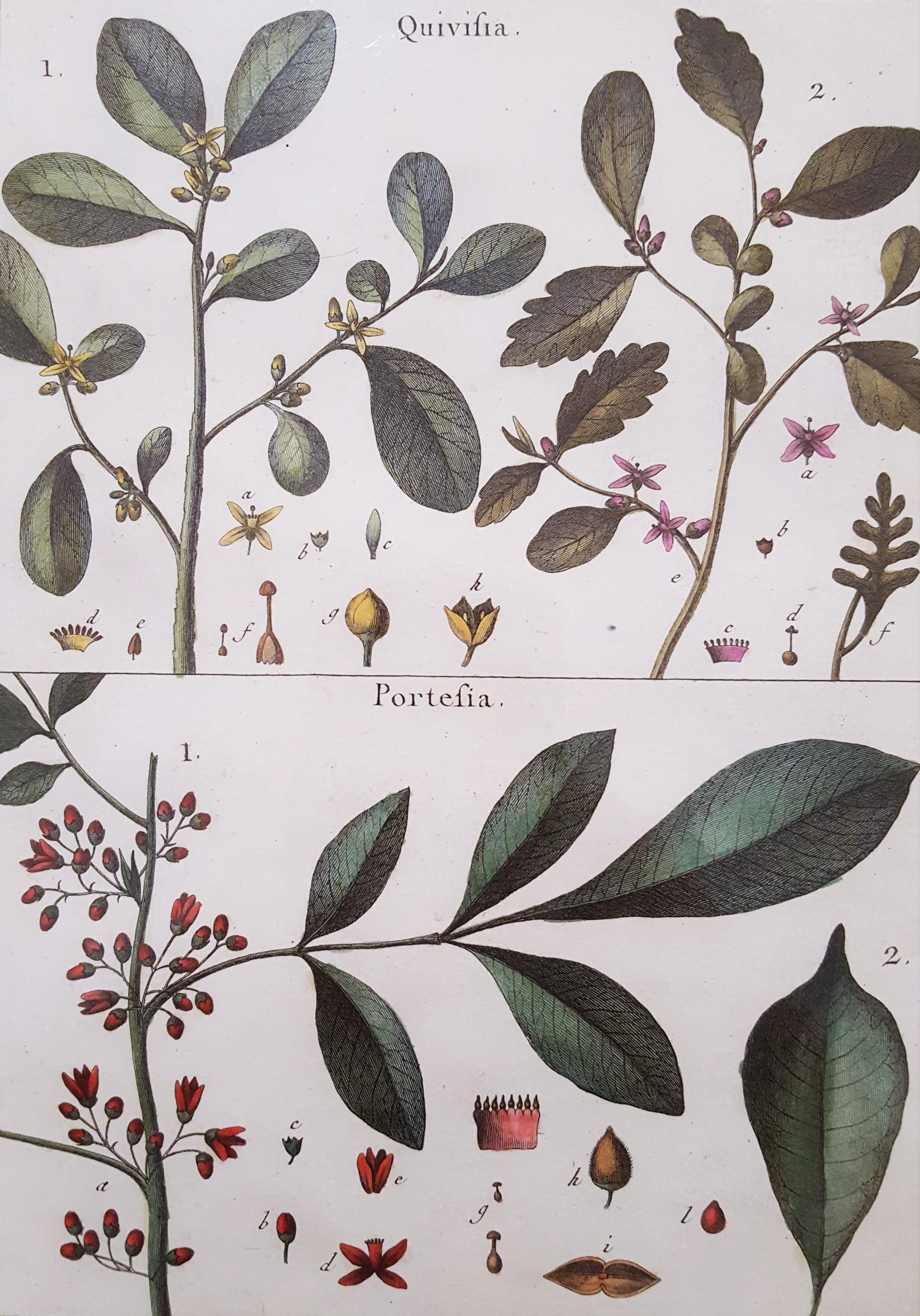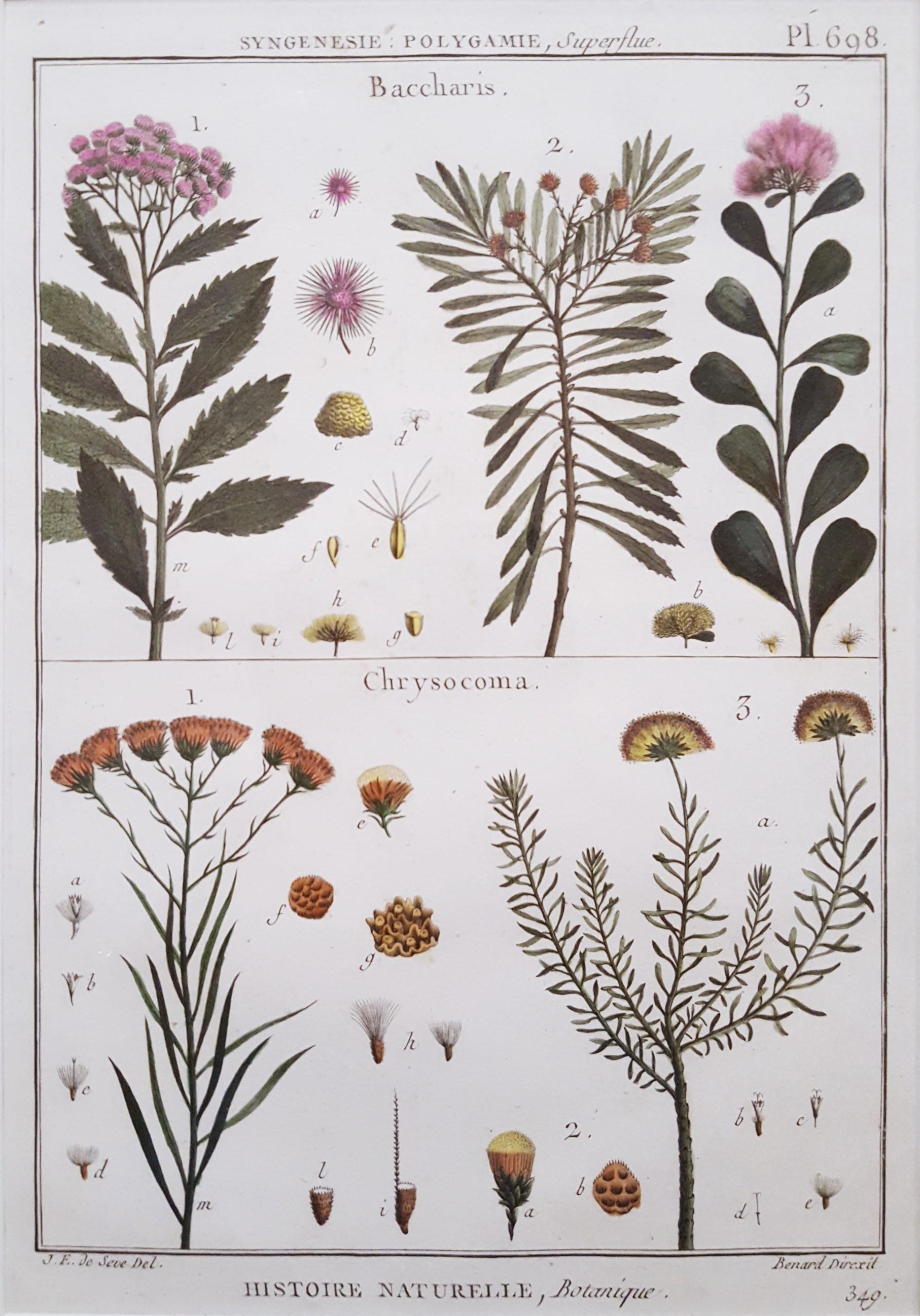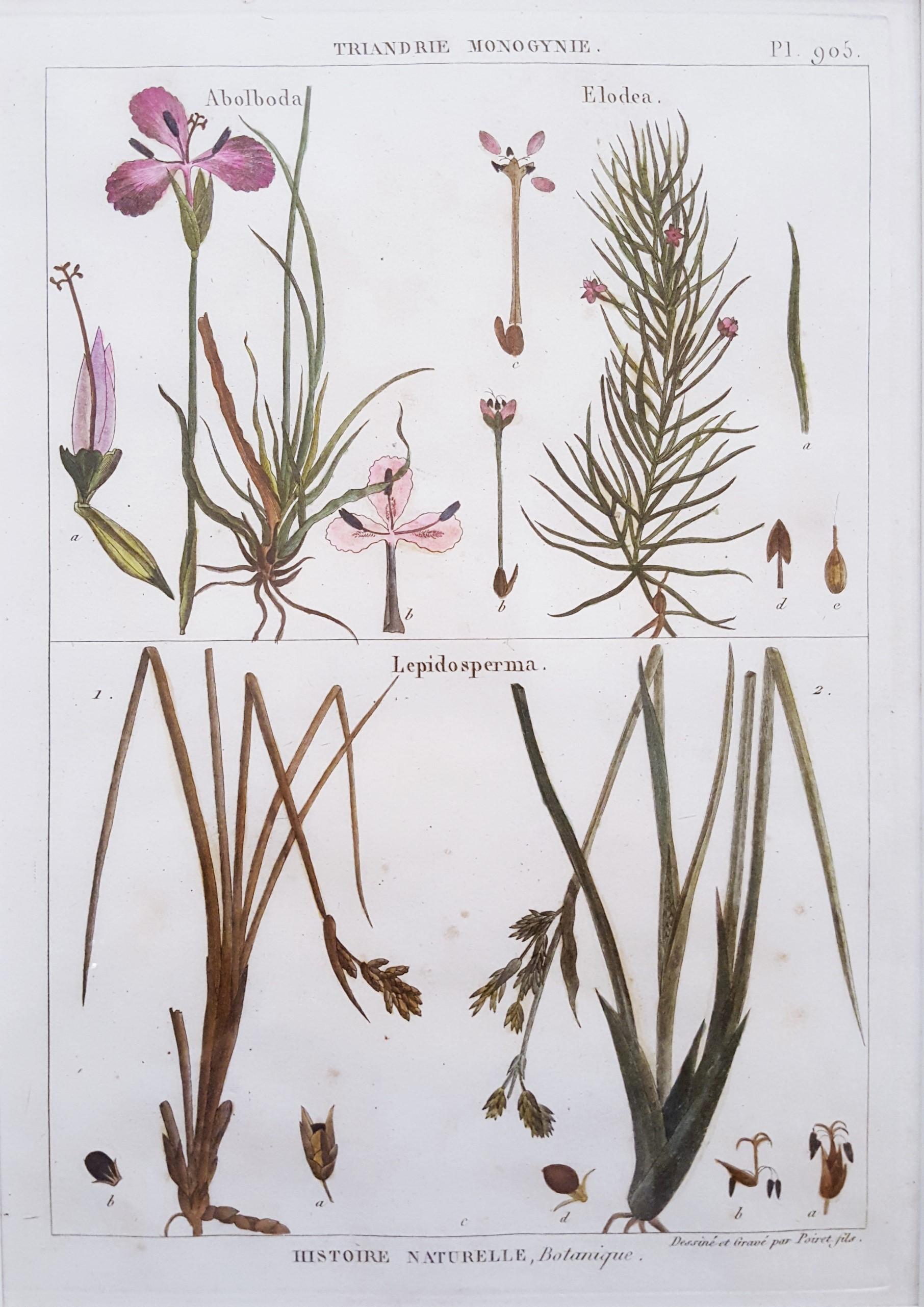Items Similar to Picris (Sunflower); Helmintia (Bristly Oxtongue) /// Botanical Botany Plants Art
Want more images or videos?
Request additional images or videos from the seller
1 of 18
Georges-Louis Leclerc, Comte de BuffonPicris (Sunflower); Helmintia (Bristly Oxtongue) /// Botanical Botany Plants Art1749-1789
1749-1789
About the Item
Artist: Georges-Louis Leclerc, Comte de Buffon (French, 1707-1788)
Title: "Picris (Sunflower); Helmintia (Bristly Oxtongue)" (Syngenesie; Polygamie, Plate 648)
Portfolio: Histoire Naturelle
Year: 1749-1789
Medium: Original Hand-Colored Engraving on laid paper
Limited edition: Unknown
Printer: Imprimerie Nationale, Paris, France
Publisher: Georges-Louis Leclerc, Comte de Buffon, Paris, France
Framing: Not framed, but beautifully double matted with hand decorated archival French matting
Matted size: 18.13" x 15.5"
Image size: 9.13" x 6.5"
Condition: Two small foxmarks upper right. One tiny puncture to paper center left. It is otherwise in very good condition
Rare
Notes:
Engraved by French artist Robert Benard (1734-1777) after a painting by French artist Jacques de Sève (fl. 1742-1788). Comes from Buffon's famous publication "Histoire Naturelle", 1749-1789, an encyclopedic collection of 36 large (quarto) volumes of Natural History.
Picris (oxtongues) is a genus in the sunflower family described as a genus by Linnaeus in 1753. Picris species are used as food plants by the larvae of some Lepidoptera species, such as the grass moth Diasemia reticularis. Schinia cardui feeds exclusively on P. hieracioides. The genus is widespread across Europe, Asia, Africa, and Australia.
Helminthotheca echioides, known as bristly (or prickly) oxtongue, is a stiff annual or biennial herb native to Europe and North Africa. It was traditionally used as an antihelminthic treatment.
Biography:
Georges-Louis Leclerc, Comte de Buffon (French: 7 September 1707 – 16 April 1788) was a French naturalist, mathematician, cosmologist, and encyclopédiste. His works influenced the next two generations of naturalists, including two prominent French scientists Jean-Baptiste Lamarck and Georges Cuvier. Buffon published thirty-six quarto volumes of his "Histoire Naturelle" during his lifetime, with additional volumes based on his notes and further research being published in the two decades following his death. Ernst Mayr wrote that "Truly, Buffon was the father of all thought in natural history in the second half of the 18th century". Buffon held the position of intendant (director) at the Jardin du Roi, now called the Jardin des Plantes.
- Creator:Georges-Louis Leclerc, Comte de Buffon (1707 - 1788, French)
- Creation Year:1749-1789
- Dimensions:Height: 18.13 in (46.06 cm)Width: 15.5 in (39.37 cm)
- Medium:
- Movement & Style:
- Period:1740-1749
- Condition:(Very Good).
- Gallery Location:Saint Augustine, FL
- Reference Number:1stDibs: LU12129069112
About the Seller
5.0
Platinum Seller
These expertly vetted sellers are 1stDibs' most experienced sellers and are rated highest by our customers.
Established in 1978
1stDibs seller since 2015
1,217 sales on 1stDibs
Typical response time: <1 hour
- ShippingRetrieving quote...Ships From: Saint Augustine, FL
- Return PolicyA return for this item may be initiated within 3 days of delivery.
More From This SellerView All
- Atraphaxis (Shrub); Cabomba (Carolina Fanwort) /// Botanical Botany Plants ArtBy Georges-Louis Leclerc, Comte de BuffonLocated in Saint Augustine, FLArtist: Georges-Louis Leclerc, Comte de Buffon (French, 1707-1788) Title: "Atraphaxis (Shrub); Cabomba (Carolina Fanwort)" (Hexandrie, Digynie, Plate 265) Portfolio: Histoire Naturel...Category
1740s Naturalistic Still-life Prints
MaterialsWatercolor, Engraving, Laid Paper, Intaglio
- Quivisia; Portesia /// Antique Botanical Botany Plants Science Engraving BuffonBy Georges-Louis Leclerc, Comte de BuffonLocated in Saint Augustine, FLArtist: Georges-Louis Leclerc, Comte de Buffon (French, 1707-1788) Title: "Quivisia; Portesia" (Octandreie, Monogynie, Plate 302) Portfolio: Histoire Naturelle Year: 1749-1789 Medium: Original Hand-Colored Engraving on laid paper Limited edition: Unknown Printer: Imprimerie Nationale, Paris, France Publisher: Georges-Louis Leclerc, Comte de Buffon, Paris, France Framing: Not framed, but beautifully double matted with hand decorated archival French matting...Category
2010s Naturalistic Still-life Prints
MaterialsWatercolor, Engraving, Laid Paper, Intaglio
- Ballota (Horehound); Marrubium (White Horehound) /// Botanical Botany Plants ArtBy Georges-Louis Leclerc, Comte de BuffonLocated in Saint Augustine, FLArtist: Georges-Louis Leclerc, Comte de Buffon (French, 1707-1788) Title: "Ballota (Horehound); Marrubium (White Horehound)" (Didynamie, Gymospermie, Plate 508) Portfolio: Histoire N...Category
1740s Naturalistic Still-life Prints
MaterialsWatercolor, Engraving, Laid Paper, Intaglio
- Euphorbia (Spurge) /// Antique Botanical Botany Plants Engraving Buffon ScienceBy Georges-Louis Leclerc, Comte de BuffonLocated in Saint Augustine, FLArtist: Georges-Louis Leclerc, Comte de Buffon (French, 1707-1788) Title: "Euphorbia (Spurge)" (Dodecandrie, Trigynie, Plate 411) Portfolio: Histoire Naturelle Year: 1749-1789 Medium...Category
1740s Naturalistic Still-life Prints
MaterialsWatercolor, Engraving, Laid Paper, Intaglio
- Baccharis (Baccharises); Chrysocoma (Golden Bitter Bush) /// Botanical BotanyBy Georges-Louis Leclerc, Comte de BuffonLocated in Saint Augustine, FLArtist: Georges-Louis Leclerc, Comte de Buffon (French, 1707-1788) Title: "Baccharis (Baccharises); Chrysocoma (Golden Bitter Bush)" (Syngenesie; Polygamie, Plate 698) Portfolio: His...Category
1740s Naturalistic Still-life Prints
MaterialsWatercolor, Engraving, Laid Paper, Intaglio
- Abolboda; Elodea (Waterweeds); Lepidosperma (Hoary Rapier-Sedge) /// BotanicalBy Georges-Louis Leclerc, Comte de BuffonLocated in Saint Augustine, FLArtist: Georges-Louis Leclerc, Comte de Buffon (French, 1707-1788) Title: "Abolboda; Elodea (Waterweeds); Lepidosperma (Hoary Rapier-Sedge)" (Triandrie Monogynie, Plate 905) Portfoli...Category
1740s Naturalistic Still-life Prints
MaterialsWatercolor, Engraving, Laid Paper, Intaglio
You May Also Like
- Pineapple with foliage.By Maria Sibylla MerianLocated in London, GB[MERIAN, Maria Sibyl]. Pineapple with foliage. The Hague, Gosse, 1719. Engraving of a Pineapple with foliage by J. Mulder, P. Sluyter and D. Stoopendaal after Merian, with later hand-colour, from Dissertatio de Generatione et Metamorphasibus Insectorum Surinamensium. Framed and glazed, overall dimensions: 40cm by 53.2cm by 4.5cm. Superb engravings which depict the metamorphoses of South American insects and the exotic plants on which they feed. Maria Sybilla, daughter of the German engraver and publisher Matthias Merian, devoted herself to the study of European insects and their metamorphoses. As a result of the wealth of tropical varieties being brought back by the Dutch West Indies Company...Category
1710s Naturalistic Still-life Prints
MaterialsWatercolor, Handmade Paper, Engraving
- POITEAU/TURPIN. Traité des arbres fruitiers: A Set of Four ApplesBy POITEAU, A. and P. TURPIN.Located in London, GBPOITEAU, A. and P. TURPIN. Traité des arbres fruitiers: A Set of Four Apples H. Perronneau for T. Delachausée, Paris, 1807-1835. A set of Four Apples, fine stipple-engrave...Category
Early 1800s Naturalistic Still-life Prints
MaterialsHandmade Paper, Engraving, Watercolor
- 4 plates from The Wondrous Transformation of Caterpillars & their Strange Diet..By Maria Sibylla MerianLocated in Middletown, NYFour plates from The Wondrous Transformation of Caterpillars and their Strange Diet of Flowers. “Wolfsmelk Rupsen;" “Wolfsmilch, Raupe und Schmetterling" Amsterdam: J F Bernard, 1730. Each an engraving with hand coloring in watercolor and gouache printed on one sheet of watermarked Honig cream laid paper, each measures 6 1/4 x 5 inches (157 x 121 mm), sheet measures 20 5/8 x 14 inches (522 x 355 mm), full margins. With one 1.5 inch inch tear across the area of the top-left corner, well outside of image area. Handling creases in the lower right sheet quadrant, as well as minor, loose cockling, otherwise in very good condition. The colors are superb with exceptionally fresh and bright saturation. Engraved between 1679 and 1683, printed 1730. Plates included: CXXI, CXXII, CXXIII, & CXXIV. MARIA SIBYLLA MERIAN was one of the most highly respected entomologists of the 17th century, and remains today one of the field's most significant figures. A German-born naturalist and scientific illustrator, she reared herself on the study of caterpillars, and made tremendous contributions to the knowledge of the life cycles of numerous species. Until her detailed and careful study of the process of metamorphosis it was thought that insects were "born of mud," through spontaneous generation. Trained as a miniature painter by her stepfather, she published her first book of illustrations in 1675, at the age of 28. In 1679, Merian published the first volume of the two-volume series on caterpillars, The Wondrous Transformation of Caterpillars and their Strange Diet of Flowers; the second volume followed in 1683. Each volume contained 50 plates that she engraved and etched. In 1699, Merian traveled to Dutch Guiana...Category
Early 18th Century Naturalistic Still-life Prints
MaterialsWatercolor, Engraving
- Cocoa plant, caterpillar, ..., Plate 26, Metamorphosis Insectorum SurinamensiumBy Maria Sibylla MerianLocated in Middletown, NYMetamorphosis Insectorum Surinamensium, Plate No. 26; Cocoa plant, caterpillar, pupa, and butterflies. The Netherlands: 1705. En...Category
Early 18th Century Naturalistic Still-life Prints
MaterialsWatercolor, Engraving
- Icecream Bean plant..., plate no. 58, Metamorphosis Insectorum SurinamensiumBy Maria Sibylla MerianLocated in Middletown, NYMetamorphosis Insectorum Surinamensium, Plate No. 58; Ice Cream Bean Plant, Cloudless Sulphur Butterfly and Caterpillar with Mot...Category
Early 18th Century Naturalistic Still-life Prints
MaterialsWatercolor, Engraving
- 4 plates from The Wondrous Transformation of Caterpillars & their Strange Diet..By Maria Sibylla MerianLocated in Middletown, NYFour plates from The Wondrous Transformation of Caterpillars and their Strange Diet of Flowers. “Wolfsmelk Rupsen;" “Wolfsmilch, Raupe und Schmetterling" Amsterdam: J F Bernard, 1730. Each an engraving with hand coloring in watercolor and gouache printed on one sheet of watermarked Honig cream laid paper, each measures 6 1/4 x 5 inches (157 x 121 mm), sheet measures 20 5/8 x 14 inches (522 x 355 mm), full margins. With handling creases in the lower right sheet quadrant, as well as minor, loose cockling, otherwise in very good condition. The colors are superb with exceptionally fresh and bright saturation. Engraved between 1679 and 1683, printed 1730. Plates included: CI; CII; CIII & CIV. MARIA SIBYLLA MERIAN was one of the most highly respected entomologists of the 17th century, and remains today one of the field's most significant figures. A German-born naturalist and scientific illustrator, she reared herself on the study of caterpillars, and made tremendous contributions to the knowledge of the life cycles of numerous species. Until her detailed and careful study of the process of metamorphosis it was thought that insects were "born of mud," through spontaneous generation. Trained as a miniature painter by her stepfather, she published her first book of illustrations in 1675, at the age of 28. In 1679, Merian published the first volume of the two-volume series on caterpillars, The Wondrous Transformation of Caterpillars and their Strange Diet of Flowers; the second volume followed in 1683. Each volume contained 50 plates that she engraved and etched. In 1699, Merian traveled to Dutch Guiana...Category
Early 18th Century Naturalistic Still-life Prints
MaterialsWatercolor, Engraving
Recently Viewed
View AllMore Ways To Browse
Antique Sunflowers
Antique Sunflower
Antique Copper Stills
Antique Copper Still
Copper Still Antique
French Naturalist
Antique Moth
Antique Herb
Jardin Antique
Des Rois
French Antique Australia
18th Century African Art
Large Still Life Of Food
Small 18th Century Still Life
Sunflower Plates
Antique Moth Prints
French Herb Art
Small 18th Century Still Life Painting





